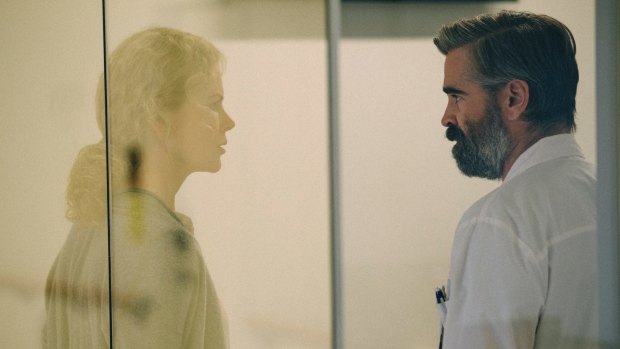By Paul Byrnes
THE KILLING OF A SACRED DEER ★★★★
(MA) 119 minutes
If you know your Greeks, you know that King Agamemnon killed a sacred deer belonging to the goddess Artemis. It was an accident, but she took a dim view. She stopped the wind so the Greek fleet could not sail against Troy. Agamemnon would have to sacrifice his daughter Iphigenia before the war could begin.
And if you know your Greek directors, you know that Yorgos Lanthimos is one of the new hopes of Greek cinema, a fresh breeze blowing across the Aegean towards Cannes and Venice and Toronto festivals, where careers are made and lost. In The Lobster, the director's first film in English, Colin Farrell played a memorable loser in search of love. That was a hit of the 2015 Cannes festival and something of an arthouse success in various countries. It was a deadpan black comedy about modern love with a bizarre premise: the inhabitants of an isolated hotel, all sad singles, had 45 days to re-partner or they would be turned into an animal of their choice. Farrell decided he'd like to be a lobster, because they can live for 100 years and remain fertile. He was accompanied by a dog, who was actually his brother.
Farrell returns here as a heart surgeon in a Midwestern American city – a sort of dim, under-populated metropolis of modest proportions (it is Cincinatti, but unnamed). Steven Murphy (Farrell) has all the trappings of success – lots of money, a nice car, a big house where his wife Anna (Nicole Kidman) runs a tight ship. She's an opthalmologist, but we never see her go to work. She tends their two beautiful and well-mannered children. Bob (Sunny Suljic) is about 10, and Kim (Raffey Cassidy), perhaps 15. The house is immaculate, with no frayed ends. Kim is learning to sing in a choir; Bob is learning to grow his hair to look cool. Dinner each night is quiet, polite, weirdly well-behaved.

Nicole Kidman and Colin Farrell in The Killing of a Sacred Deer.Credit: Madman Films
From the first moment, when the camera opens up on a beating human heart exposed to the light of surgery, we know we are not in Kansas any more, if that be the recognisable, ordinary, everyday world. Lanthimos doesn't work in that world. He creates his own, and in this one, people talk like robots. It's a Stepford world, emphasised by wide-angle lenses and long unblinking shots of ordered architectural spaces – modern, well-lit, comforting in a sterile kind of way. The presence of Kidman underlines that: she's the iciest goddess of modern cinema. Even so, the heart of this story is far from modern.
The surgeon has a friend. Martin (Barry Keoghan) is 16 and at first we think he's the doctor's boyfriend. Murphy gives him an expensive watch. Martin hasn't been put together with all the parts in the right place: his speech is staccato and direct, and he startles people. He hugs the surgeon but his affection is awkward. It takes a while before we understand his purpose. Sixteen years earlier, a tragedy befell his family; now he brings Murphy a choice, along the lines of the one Artemis gave Agamemnon.
This premise, holding a doctor to highly personal account for his professional mistake, is interesting, even a little classical. Even more unexpected is that much of the early part is played as dark comedy. None of the characters sees the joke. That just makes the absurd style and dialogue funnier. Later, as the situation becomes terrifyingly dramatic, we expect the comedy to disappear but it never does. That makes the drama more painful.
I saw it with a young inner-city audience and they did not know whether to laugh or cry as Lanthimos drags us into the very darkest of human choices – where the gods have their sport. Many of these youngsters left scratching their heads, like they'd never seen such a movie – and they're right. Very few movies of this century have anything like the gravity or intensity or poetic licence that Lanthimos brings to this story, but he's Greek. They invented this stuff. What's Greek for drama?